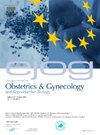妊娠后期下尿路症状:横断面研究和叙事回顾
IF 1.9
4区 医学
Q2 OBSTETRICS & GYNECOLOGY
European journal of obstetrics, gynecology, and reproductive biology
Pub Date : 2025-09-29
DOI:10.1016/j.ejogrb.2025.114743
引用次数: 0
摘要
目的:探讨妊娠晚期妇女下尿路症状(LUTS)的患病率及其对生活质量(QoL)的影响。方法:本横断面研究在妊娠28-41周的孕妇中进行。在线布里斯托尔女性下尿路症状问卷用于评估LUTS。此外,我们还进行了文献综述,以确定妊娠后期LUTS的患病率范围。结果:334名参与者的数据被分析,平均年龄28.9±6.4岁,中位胎龄36周(IQR: 33-39)。在储存症状中,夜尿是最常见的症状,198例(59.3%),其次是尿频122例(36.5%),尿急68例(20.4%),膀胱疼痛52例(15.6%)。关于尿失禁症状,47名女性(14.1%)报告了压力性尿失禁(SUI)。夜尿症的严重程度最大,对生活质量的负面影响最显著。产妇年龄大于35岁、体重指数(BMI)≥25 kg/m2与SUI发生显著相关(P = 0.02、P = 0.03)。23项研究的描述性分析显示,妊娠后期LUTS的患病率范围如下:夜尿症(6.9% ~ 97.4%)、尿频(22.9% ~ 80.9%)、尿急(2.2% ~ 83.4%)和SUI(5.8% ~ 72.9%)。结论:LUTS在妊娠晚期普遍存在,对生活质量有不利影响。我们建议通过改变生活方式对LUTS进行常规评估和管理,以提高孕妇的生活质量。本文章由计算机程序翻译,如有差异,请以英文原文为准。
Lower urinary tract symptoms in late pregnancy: A cross-sectional study and narrative review
Objective
To evaluate the prevalence of lower urinary tract symptoms (LUTS) and their effect on quality of life (QoL) among women in the third trimester of pregnancy.
Methods
This cross-sectional study was conducted among pregnant women at 28–41 weeks of gestation. The online Bristol Female Lower Urinary Tract Symptoms questionnaire was used to assess LUTS. Additionally, a literature review was conducted to identify the prevalence range of LUTS in late pregnancy.
Results
Data from 334 participants, with a mean age of 28.9 ± 6.4 years and a median gestational age of 36 weeks (IQR: 33-39) were analyzed. Among storage symptoms, nocturia was the most frequently reported symptom, affecting 198 women (59.3 %), followed by urinary frequency in 122 (36.5 %), urgency in 68 (20.4 %), and bladder pain in 52 (15.6 %). Regarding incontinence symptoms, 47 women (14.1 %) reported stress urinary incontinence (SUI). Nocturia exhibited the greatest severity and the most significant negative impact on QoL. Maternal age greater than 35 years and body mass index (BMI) ≥ 25 kg/m2 were significantly associated with the development of SUI (P = 0.02 and P = 0.03, respectively). Descriptive analysis of 23 studies revealed prevalence ranges of LUTS in late pregnancy as follows: nocturia (6.9 % to 97.4 %), urinary frequency (22.9 % to 80.9 %), urgency (2.2 % to 83.4 %), and SUI (5.8 % to 72.9 %).
Conclusions
LUTS are prevalent during late pregnancy and adversely impact QoL. We recommend routine assessment and management of LUTS through lifestyle modifications to enhance QoL among pregnant women.
求助全文
通过发布文献求助,成功后即可免费获取论文全文。
去求助
来源期刊
CiteScore
4.60
自引率
3.80%
发文量
898
审稿时长
8.3 weeks
期刊介绍:
The European Journal of Obstetrics & Gynecology and Reproductive Biology is the leading general clinical journal covering the continent. It publishes peer reviewed original research articles, as well as a wide range of news, book reviews, biographical, historical and educational articles and a lively correspondence section. Fields covered include obstetrics, prenatal diagnosis, maternal-fetal medicine, perinatology, general gynecology, gynecologic oncology, uro-gynecology, reproductive medicine, infertility, reproductive endocrinology, sexual medicine and reproductive ethics. The European Journal of Obstetrics & Gynecology and Reproductive Biology provides a forum for scientific and clinical professional communication in obstetrics and gynecology throughout Europe and the world.

 求助内容:
求助内容: 应助结果提醒方式:
应助结果提醒方式:


